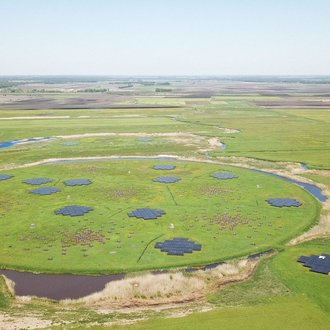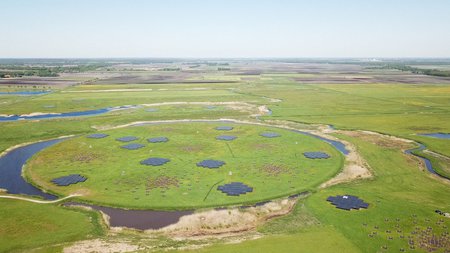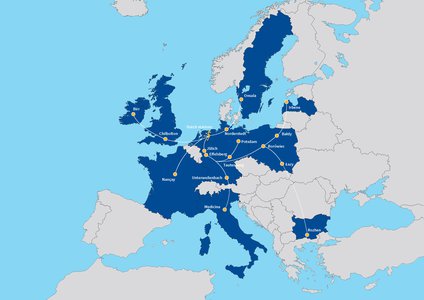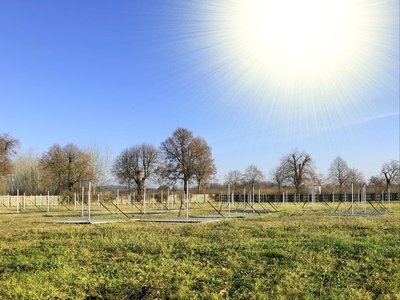LOFAR ERIC: Distributed Research Infrastructure for European Astronomical Research Launched

The centrepiece of the huge, ultra-modern radio telescope, which covers the whole of Western Europe, is located in Exloo in the Netherlands.
Credit: NWO-I/ASTRONThe Low Frequency Array (LOFAR) world’s largest and most sensitive radio telescope operating at low radio frequencies. LOFAR was previously organised as a project and is now being transformed into an independent legal form: a consortium for a European research infrastructure (European Research Infrastructure Consortium, ERIC). The European Commission had decided to set up LOFAR as an ERIC due to the Europe-wide significance of the radio telescope. LOFAR ERIC was officially founded 22 January 2024.
Ten years ago, the LOFAR radio telescope went into operation. Today, It is a Europe-wide distributed research infrastructure that consists of 52 antenna stations in eight European countries. The Leibniz Institute for Astrophysics Potsdam (AIP) operates a LOFAR station in Potsdam-Bornim, which consists of a low-band (10–90 MHz) and high-band (110–250 MHz) antenna array, each with a diameter of 70 metres. The joint project revolutionised low-frequency radio astronomy research and led to an avalanche of scientific publications.
Six EU countries applied to the European Commission to set up LOFAR ERIC and are therefore its founding members: Bulgaria, Germany, Ireland, Italy, the Netherlands and Poland. The new research organisation collaborates with institutes in France, Latvia, Sweden and the United Kingdom. Its statutory seat is in Dwingeloo, at the Netherlands Institute for Radio Astronomy (NWO-I/ASTRON), where the LOFAR radio telescope was originally constructed. LOFAR ERIC has been officially launched there today, when the first Council meeting of the new research organisation took place.
LOFAR ERIC will modernise the distributed infrastructure, and serve the astronomy community with a cutting-edge suite of observing and data processing capabilities, rooted in its vast field of view on sky, unprecedented sensitivity and image resolution, and novel capabilities to observe in multiple directions all at once.
"The fact that LOFAR ERIC opens the window to the stars is not only of great and excellent value for science, but also for European research policy," says Professor Dr. Dominik Schwarz from Bielefeld University. As a member of the German Long Wavelength Consortium (GLOW), he played a key role in setting up the new research institution - both as Vice-Chairman of the Board of the International LOFAR Telescope (ILT) and as a representative of German science on the LOFAR ERIC's development committee. "We have spent half a decade working towards the establishment of LOFAR. This has now been rewarded," explains Schwarz.
"The establishment of LOFAR ERIC consolidates world-leading excellence for Europe in an important research field," said Dr. René Vermeulen, founding director of LOFAR ERIC. "With its unrivalled distributed research infrastructure and its robust pan-European partnership, LOFAR ERIC enters the European Research Area as a powerhouse at the cutting edge of astronomy science and technology, with the potential to contribute to broader complex challenges."
The new LOFAR facility will empower researchers to pursue large-scale innovative projects across scientific domains. This includes research into the early phase of the universe, the formation and evolution of galaxies, the physics of pulsars and transient radio phenomena. Other research topics include the nature of ultra-high energy cosmic particles, the conditions in the interstellar medium, and the structure of cosmic magnetic fields. Furthermore, LOFAR ERIC contributes unique scientific insights into various topics with societal relevance, such as lightning, ionospheric disturbances and space weather.
As a research organisation with a long-term perspective, LOFAR ERIC provides the European and global community with reliable access to a wide range of scientific research services. LOFAR ERIC will facilitate access to its extensive science data products through its user-friendly, publicly accessible archive.
The German universities and research institutes participating in LOFAR ERIC are: the Universities of Bielefeld, Bochum, Erlangen-Nuremberg, Hamburg and Würzburg as well as the Research Center Forschungszentrum Jülich, the Leibniz Institute for Astrophysics Potsdam, the Max Planck Institute for Astrophysics in Garching, the Max Planck Institute for Radio Astronomy in Bonn and the Thüringer Landessternwarte Tautenburg.
Further information
For more information about LOFAR ERIC and its initiatives, please visit the LOFAR ERIC website: https://www.lofar.eu
LOFAR-Website des Deutschen Konsortiums zur Messung langer Radiowellen (GLOW)
German partners and stations of the Low Frequency Array:
Unterweilenbach (FAU Erlangen-Nürnberg, JMU Würzburg, MPA Garching)
Images
The centrepiece of the huge, ultra-modern radio telescope, which covers the whole of Western Europe, is located in Exloo in the Netherlands.
Big screen size [1000 x 562, 120 KB]
Original size [2560 x 1440, 700 KB]
The 52 LOFAR antennae stations are distributed across eight European countries. The telescope consists of 24 core stations in the region of Exloo in the Netherlands, 14 additional stations in the Netherlands and 14 international stations.
Big screen size [1000 x 706, 70 KB]
Original size [2481 x 1754, 300 KB]
The AIP LOFAR station in Potsdam Bornim.
Big screen size [1000 x 749, 190 KB]
Original size [3166 x 2374, 1.6 MB]





